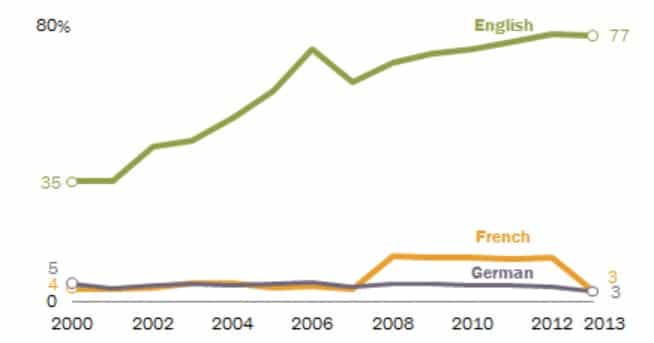How to Understand your IELTS Score

- IELTS Bands
- How does an IELTS score translate to a CEFR score?
- How is the IELTS Listening Section scored?
- How is the IELTS Reading Section scored?
- How is the IELTS Writing Section scored?
- How is the IELTS Speaking Section scored?
IELTS Bands
IELTS has its own method of scoring tests that can seem a bit confusing at first. Depending on where you are from, you might be more used to scoring as A+ A A- B+ B B-, or as a percentage, however IELTS has a system of bands. The bands range from a 0 when you don’t show, to a 9, which is a perfect score. Half point scores are possible, and you can see in the folowing table that the total of all your 4 scores are averaged to get your final IELTS test score.
| Listening | Reading | Writing | Speaking | Overall |
| 7 | 6.5 | 6 | 6.5 | 6.5 |
To find you overall score, add together the band scores for the 4 sections:
7 + 6.5 + 6 + 6.5 = 26
Next, divide your answer by 4:
26 ÷ 4 = 6.5
So, 6.5 is your overall IELTS band score
How does an IELTS score translate to a CEFR score?
The Common European Framework of Reference for Languages (CEFR) is a widely recognized system for evaluating and comparing language proficiency. It divides language ability into six levels: A1, A2, B1, B2, C1, and C2. The CEFR levels are based on a set of language competencies that are described in detail in the CEFR document.
IELTS scores can be roughly translated to CEFR levels as follows:
| IELTS band | CEFR level |
| 9 | C2 |
| 8 | C1 |
| 7 | C1 |
| 6 | B2 |
| 5 | B1 |
| 4 | B1 |
| 3 | A2 |
| 2 | A1 |
| 1 | A1 |

This is another way to visualise the IELTS bands and their correspondance with the CEFR levels. Please note:
- 8 is a borderline C2 score, while 8.5 is a definite C2 score
- 6.5 is a borderline C1 score, while 7 is a definite C1 score.
- 5.5 is a borderline B2 score
- 4 is a borderline B1 score
It is important to note that this is just a rough guide and that the actual translation of an IELTS score to a CEFR level may vary depending on the specific requirements of the organization or institution that you are applying to. Some institutions may have their own conversion tables or may use a different method to convert IELTS scores to CEFR levels. It is always a good idea to check with the specific organization or institution to determine their requirements and how they will interpret your IELTS score.
How is the IELTS Listening Section scored?
The listening section of the IELTS exam is scored based on the number of correct answers that you provide. There are 40 questions in the listening section, and each correct answer is worth one point. Therefore, the maximum score you can receive on the listening section is 40 points. You get one point for each correct answer. You do not lose points for wrong answers, so it is important to always give an answer, even if you are unsure.
The listening section is designed to test your ability to understand spoken English in a variety of contexts, including lectures, conversations, and news broadcasts. You will be presented with a series of recorded audio clips and will be asked questions about what you hear. The questions may ask you to identify specific information, to understand the main ideas, or to infer meaning from the context.
Your overall band score for the listening section will be based on your total number of correct answers and will be calculated according to the following scale:
IELTS Listening Band Scores
| # Correct Answers | IELTS Band score |
|---|---|
| 39-40 | 9 |
| 37-38 | 8.5 |
| 35-36 | 8 |
| 32-34 | 7.5 |
| 30-31 | 7 |
| 26-29 | 6.5 |
| 23-25 | 6 |
| 18-22 | 5.5 |
| 16-17 | 5 |
| 13-15 | 4.5 |
| 11-12 | 4 |

How is the IELTS Reading Section scored?
The reading section of the IELTS exam is scored based on the number of correct answers that you provide. There are 40 questions in the reading section, and each correct answer is worth one point. Therefore, the maximum score you can receive on the reading section is 40 points.
The reading section is designed to test your ability to understand and interpret a variety of texts, including newspaper articles, magazine articles, and academic texts. You will be asked questions that require you to identify specific information in the texts, as well as questions that require you to understand the main ideas and themes of the texts.
IELTS Academic (AC) Reading Band Scores
| # Correct Answers | IELTS Band score |
|---|---|
| 39-40 | 9 |
| 37-38 | 8.5 |
| 35-36 | 8 |
| 33-34 | 7.5 |
| 30-32 | 7 |
| 27-29 | 6.5 |
| 23-26 | 6 |
| 19-22 | 5.5 |
| 15-18 | 5 |
| 13-14 | 4.5 |
| 10-12 | 4 |
| 8-9 | 3.5 |
| 6-7 | 3 |
| 4-5 | 2.5 |
IELTS General Training (GT) Reading Band Scores
| Raw scores | Band scores |
|---|---|
| 40 | 9 |
| 39 | 8.5 |
| 37-38 | 8 |
| 36 | 7.5 |
| 34-35 | 7 |
| 32-33 | 6.5 |
| 30-31 | 6 |
| 27-29 | 5.5 |
| 23-26 | 5 |
| 19-22 | 4.5 |
| 15-18 | 4 |
| 12-14 | 3.5 |
| 9-11 | 3 |
| 6-8 | 2.5 |
How is the IELTS Writing Section scored?
The IELTS writing test is scored on a band scale from 0 to 9. You will receive a separate score for each of the four skills (reading, listening, writing, and speaking) and an overall band score. The writing test is marked by trained examiners who follow strict assessment criteria. The criteria include four main areas: task achievement, coherence and cohesion, lexical resource, and grammatical range and accuracy. The score you receive will be based on how well you demonstrate these skills in your writing.
How is the IELTS Speaking Section scored?
The speaking section of the IELTS exam is scored based on four criteria: fluency and coherence, lexical resource, grammatical range and accuracy, and pronunciation. Each criterion is scored on a scale from 0 to 9, and the scores are then averaged to determine your overall band score for the speaking section.
Fluency and coherence refer to how smoothly and logically you express your ideas. Lexical resource refers to the range and accuracy of your vocabulary. Grammatical range and accuracy refer to the variety and correctness of your grammar. Pronunciation refers to how clearly and accurately you articulate sounds and words. Your overall band score for the speaking section will be based on your performance in all four criteria.






